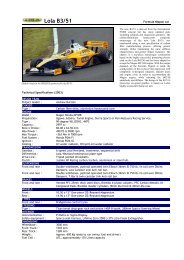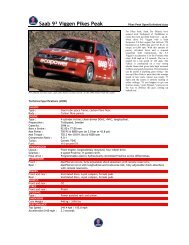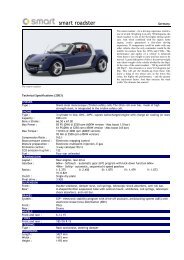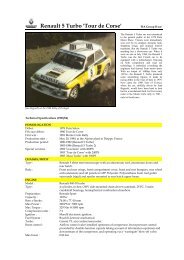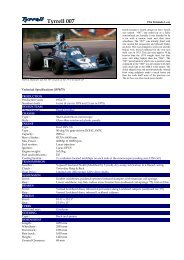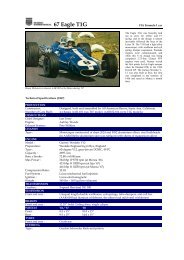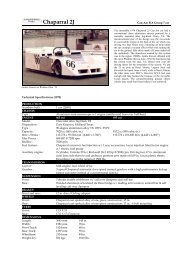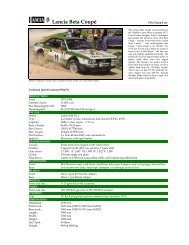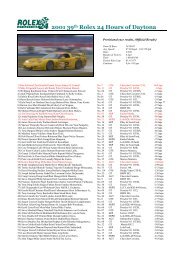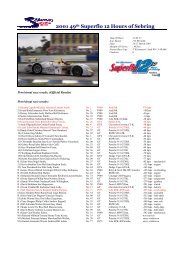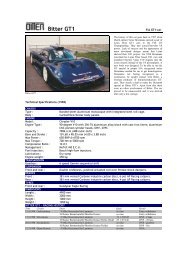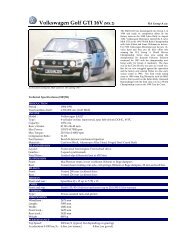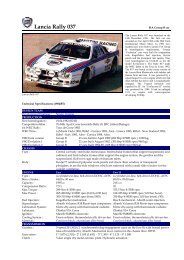02 Juno Racing Ltd SS1 - Motorsports Almanac
02 Juno Racing Ltd SS1 - Motorsports Almanac
02 Juno Racing Ltd SS1 - Motorsports Almanac
Create successful ePaper yourself
Turn your PDF publications into a flip-book with our unique Google optimized e-Paper software.
The <strong>Juno</strong> <strong>Racing</strong> <strong>Ltd</strong> <strong>SS1</strong>.<br />
Technical Specification (20<strong>02</strong>/03)<br />
<strong>Juno</strong> <strong>Racing</strong> <strong>Ltd</strong> <strong>SS1</strong> Supersports SP car<br />
The <strong>Juno</strong> <strong>Racing</strong> <strong>Ltd</strong> <strong>SS1</strong> sports prototype<br />
racing car has been built to compete in the<br />
UK National Supersports championship. The<br />
car has been designed with versatility in<br />
mind and could be configured to suit a range<br />
of championships and formulae. The car has<br />
been assembled using only the highest<br />
quality components right down to the<br />
military specification nuts and bolts and ETA<br />
circuit breakers. The <strong>Juno</strong> <strong>Racing</strong> <strong>Ltd</strong> design<br />
team believes it to be worth the extra expense<br />
in buying such equipment, in order to ensure<br />
reliability and performance. The following<br />
technical specification will describe the<br />
configuration of the car, as seen at the<br />
Autosport International show 2001.<br />
Suggestions for potential modifications to<br />
enable the car to compete in different<br />
formulae appear towards the end of this page.<br />
DESIGN TEAM<br />
Chief Designer : Ewan Baldry (former Williams design engineer)<br />
Design engineer : Ben Lang (also current chief engineer on the Tuscan Speed Six road car)<br />
CHASSIS<br />
Type : Steel tubular space frame. The material used is CDS (Cold Drawn Seamless) steel<br />
tube of varying dimensions. The integral roll structure again from CDS tubing<br />
satisfies MSA (UK Motorsport Association) requirements. The <strong>Juno</strong> roll structure is<br />
made form 50mm diameter tube with a 2mm wall thickness. The bend radius is<br />
160mm. Higher specification T45 tubing can be used on request. 65 kg weight.<br />
Torsional rigidity : In excess of 22,000 Nm/deg.<br />
Body : 3 main GRP (glass reinforced plastic) sections. The central section remains fixed<br />
to the chassis. The nose and tail section are quickly removable upon operating<br />
the quarter turn and over-centre fasteners. Four section floor made from carbon<br />
fibre skins with a foam core. There are two main panels plus the front underbody<br />
(splitter) and the diffuser.<br />
Rear Aerofoil : Twin element pre-preg carbon composite aerofoil.<br />
ENGINE<br />
Type : 4-cylinder in-linem DOHC, 4VPC<br />
Model : Vauxhall/Opel 20XE OLE 00<strong>02</strong><br />
Preparation : Swindon Race Engines or P&P Autocare.<br />
Capacity : 1998 cc<br />
Bore x Stroke : 86.00 x 86.00 mm<br />
Max Power : 220 bhp<br />
Carburettors : 2 x 45 mm Weber 45DCOE Type 152<br />
Camshaft : SRE/P10 or NS-SP1 (as supplied by NSA)<br />
Lubrication System : Dry-sump<br />
Ignition control box : MBE/99/SP1 MSA Sealed (with rev. limiter OLE 0008 or OLE 0008/76 MSA sealed)<br />
TRANSMISSION<br />
Gearbox : 5-speed Staffs Silent Gears Kwikshift, H-pattern shift (sequential shift optional).<br />
Clutch : AP <strong>Racing</strong> twin plate.<br />
SUSPENSION<br />
Front and rear : Un-equal length double 4130 steel alloy wishbones. Pushrod operated Öhlins<br />
46HRC double adjustable dampers, Eibach springs. Fabricated steel Uprights.<br />
djustable switchblades control roll. Cockpit adjustment is possible if required.<br />
BRAKES<br />
Front and rear : 280mm vented cast iron discs, Billet aluminium 4-piston calipers. Ferodo carbon<br />
metallic pads. Cockpit adjustable balance bar.<br />
WHEELS<br />
Front and rear : Dallara F3 specification OZ magnesium alloy castings centre-lock<br />
TYRES<br />
Front : DUNLOP SP1 DRY 190/535R-13 'Supersport' or 170/510-13 "894"<br />
DUNLOP SP1 WET 190/535R-13 'Wet' or 170/510-13 "Wet"
Rear : DUNLOP DRY 230/570R-13 'Supersport' or 210/570-13 "894"<br />
DUNLOP WET 190/535R-13 'Wet' or 210/570-13 "Wet"<br />
STEERING<br />
Type : Titan Rack-and-pinion. Momo Model 27 steering wheel with SPA quick release.<br />
COCKPIT<br />
Instruments : Oil Pressure, Oil Temperature, Water Temperature, Engine Revs,<br />
Data acquisition : Pi<br />
Safety Harness : Willans six-point safety harness.<br />
ELECTRICS<br />
Wiring loom : Custom built with heat-shrink for durability. ITT Canon Sure-Seal connectors. ETA<br />
circuit breakers<br />
DIMENSIONS<br />
Wheelbase : 2400mm<br />
Front Track : 1411mm<br />
Rear Track : 1520mm<br />
Overall Weight : 510kg (excluding driver in National Supersports spec)<br />
Power to Weight : 431 bhp/tonne<br />
PRODUCTION<br />
Price : £35,000 plus VAT (to National Supersports specification less engine)<br />
Manufacturer : Ewan Baldry, <strong>Juno</strong> <strong>Racing</strong> <strong>Ltd</strong>, 11 Athlone Avenue, Blackpool, Lancashire,<br />
FY2 9UY, England<br />
E-mail : ewanb@junoracing.co.uk<br />
Phone : 07971 531763<br />
THE JUNO <strong>SS1</strong> SPORTS PROTOTYPE<br />
The <strong>Juno</strong> <strong>Racing</strong> <strong>Ltd</strong> <strong>SS1</strong> sports prototype racing car has been built to compete in the UK National<br />
Supersports championship. The car has been designed with versatility in mind and could be configured to<br />
suit a range of championships and formulae. The car has been assembled using only the highest quality<br />
components right down to the military specification nuts and bolts and ETA circuit breakers. The <strong>Juno</strong><br />
<strong>Racing</strong> <strong>Ltd</strong> design team believes it to be worth the extra expense in buying such equipment, in order to<br />
ensure reliability and performance. The following technical specification will describe the configuration of<br />
the car, as seen at the Autosport International show 2001. Suggestions for potential modifications to enable<br />
the car to compete in different formulae appear towards the end of this page. The <strong>Juno</strong> <strong>Racing</strong> <strong>Ltd</strong> design<br />
team will be happy to discuss any design requirements.<br />
THE JUNO RACING LTD <strong>SS1</strong> – DESCRIPTION<br />
Chassis<br />
The chassis is a steel tubular space frame construction as mandated by National Supersports regulations. The<br />
material used is CDS (Cold Drawn Seamless) steel tube of varying dimensions. The integral roll structure<br />
again from CDS tubing satisfies MSA (UK Motorsport Association) requirements. This mandates a minimum<br />
tube diameter, wall thickness and bend radius. The <strong>Juno</strong> roll structure is made form 50mm diameter tube<br />
with a 2mm wall thickness. The bend radius is 160mm. Higher specification T45 tubing can be used on<br />
request. This could lead to a small weight saving in the chassis construction. During the design phase, the<br />
fundamental chassis layout was subject to many hours of computer based stress analysis in an effort to<br />
improve the stiffness to weight ratio of the chassis. The end result is a chassis with a torsional rigidity in<br />
excess of 22,000 Nm/deg and an overall weight of just 65 kg.<br />
Suspension<br />
The basic suspension layout is un-equal length double wishbones front and rear. Pushrods operate billet<br />
aluminium machined bell cranks that in turn actuate Ohlins 46HRC double adjustable dampers and Eibach<br />
springs. Uprights, front and rear are steel fabricated units, offering excellent installation stiffness, bearing<br />
retention as well as being lightweight. Wishbones are made from 4130 steel alloy tubing. Aero-section<br />
wishbone tubing is also available at an increased cost. All spherical joints are either Silverline or Goldline<br />
Ampep bearings. Adjustable switchblades control roll. Cockpit adjustment is possible if required. Camber<br />
adjustment is made by the adding or removal of laser cut shims. The shims are fitted between the billet<br />
machined steering arm and the upright. With multiple wishbone pick-up points, the car can be set up with<br />
anti-dive and anti-squat geometry as required. The rear suspension is mounted via a billet machined<br />
aluminium shear plate. This ensures dimensional accuracy of the suspension installation and therefore eases<br />
car set-up. Customer cars will also benefit from the same concept at the front end of the chassis, following<br />
a re-design of the method for suspension mounting. The new design features a similar shear plate fitted to<br />
the front of the space frame, onto which bolts the wishbones, steering rack, dampers, bell cranks and pedal<br />
box.<br />
Transmission<br />
The <strong>Juno</strong> <strong>Racing</strong> <strong>Ltd</strong> <strong>SS1</strong> car uses the Staffs Silent Gears Kwikshift 5-speed trans-axle gearbox. Although an<br />
H-pattern shift is fitted as standard, to comply with National Supersports regulations, a sequential shift<br />
mechanism can be fitted with very little additional cost. The gearbox has been used in the National<br />
Supersports class for many years and proves to be very durable. Hewland Mk-9 ratios are used and are<br />
readily available. This gearbox is probably nearing its performance envelope transmitting the 220bhp from<br />
the Vauxhall engine that is currently fitted to the car. For engines producing greater torque a gearbox from<br />
the Hewland range could be fitted to the car with minor changes being made to the aluminium sheer plate.
Engine<br />
The car is currently fitted with a Vauxhall 2.0 litre XE engine that has been tuned to National Supersports<br />
regulations. The engine is dry-sumped and has been fitted with cams of unique profile designed for the<br />
National Supersports championship. An MBE ignition box and twin Weber 45 DCOE carburettors result in<br />
power output of around 220 bhp. The engine bay is very adaptable and the chassis could accommodate<br />
anything from a Suzuki Hayabusa bike engine through to a V8.<br />
Steering<br />
Steering is actuated via the ubiquitous Titan steering rack. This operates billet machined steering arms. The<br />
steering pinion gear housing takes the form of an eccentric bush. This facilitates the fitting of a range of<br />
pinion gears, therefore allowing the steering ratio to be altered to suit any kind of circuit or driver<br />
preference. The steering column is fitted with top specification Apex universal joints (helicopter joints). To<br />
ease entry and exit to the cockpit, the steering wheel is fitted with the SPA quick release steering wheel<br />
boss. The Momo model 27 steering wheel with flat bottom is fitted as standard.<br />
Bodywork<br />
The bodywork is split into 3 main sections. The central section remains fixed to the chassis. The nose and<br />
tail section are quickly removable upon operating the quarter turn and over-centre fasteners. The bodywork<br />
is made from GRP (glass reinforced plastic). A single laminate is used in order to keep weight down. The<br />
company now has access to facilities that would allow the bodywork to be manufactured from pre-preg<br />
carbon or glass composite materials. Pre-preg, oven cured bodywork would offer a weight saving in excess of<br />
20kg. The additional cost is likely to be around £3000. The floor is made from carbon fibre skins with a foam<br />
core. The use of such materials results in very lightweight panels. The floor is split into four sections to ease<br />
maintenance. There are two main panels plus the front underbody (splitter) and the diffuser.<br />
Braking<br />
The car is fitted with an AP <strong>Racing</strong> Formula 3 braking system. This set-up includes: Billet aluminium four<br />
piston calipers, front and rear. 280mm diameter vented discs. Ferodo carbon metallic pads. Braking is<br />
controlled via a cockpit adjustable balance bar. The rear braking system is fitted with a dry-brake coupling<br />
to allow the rear end of the car to be removed and replaced without the need for brake bleeding.<br />
Clutch<br />
The car is fitted with an AP racing twin plate clutch. A hydraulic annular piston is used for clutch release.<br />
The clutch system is fitted with a dry-brake coupling to allow the rear end of the car to be removed and<br />
replaced without the need for clutch bleeding.<br />
Wheels<br />
The car runs on Dallara F3 specification OZ centre-lock wheels. The wheels are magnesium alloy castings<br />
thus making them extremely light. These wheels are suitable to take the mandatory Dunlop "Clubmans" slick<br />
or wet tyre. Alternatively, if the car were to be used for a different application, readily available Avon F3<br />
tyres could be fitted.<br />
Rear Aerofoil<br />
The car is supplied with a twin element pre-preg carbon composite aerofoil. The flap allows the wing to be<br />
tuned to suit a range of circuits.<br />
Safety Harness<br />
The car is fitted with a Willans six-point safety harness.<br />
Electrical Equipment and Wiring<br />
The car is fitted with a custom built wiring loom; the loom is finished with heat-shrink for durability. All<br />
wiring connections are made with ITT Canon Sure-Seal connectors. The electrical circuits are protected with<br />
ETA circuit breakers as chosen by touring car, rally and GT teams.<br />
Instrumentation<br />
The car is supplied fitted with gauges indicating: Oil Pressure, Oil Temperature, Water Temperature, Engine<br />
Revs, The car can be fitted with any data logging system from the Pi range as required.<br />
Nuts and Bolts<br />
The car is assembled using military aircraft specification NAS bolts and " K- Nuts ".<br />
Maintenance<br />
During the design of the car, care has been taken to ensure that the car is simple to work on. One major<br />
feature of the car is that the whole of the rear end can be removed or fitted as a complete sub-assembly.<br />
Undoing four nuts allows the rear shear plate, onto which is mounted the gearbox, rear suspension and rear<br />
wing mounts to be removed as a unit. This allows an engine change to take place in about 1 hour. If<br />
required, a fully built up rear end assembly could be carried for emergency replacement.<br />
Alternative Applications for the <strong>Juno</strong> <strong>SS1</strong><br />
Many people who visited the <strong>Juno</strong> <strong>Racing</strong> <strong>Ltd</strong> stand at the Autosport International show enquired about the<br />
possibility of adapting the car to suit other formulae and racing categories. The following section describes<br />
some of the fundamental alterations that would need to be made to suit some of the categories mentioned.<br />
This is by no means a definitive list and anybody wishing to pursue a particular route should contact us to<br />
discuss their ideas further. The car would obviously be eligible to compete in hillclimb and sprint events as<br />
it is. Obviously National Supersports regulations restrict engine power that might be unnecessary for<br />
hillclimbing or sprinting. The car could be adapted to suit the SR2 class for the Sports <strong>Racing</strong> World Cup.<br />
This would require an extension of the wheelbase by around 150mm. This would require small bodywork<br />
modifications. The SR2 class prohibits the use of both carbon composite chassis and tubular spaceframe<br />
chassis. The remaining option is an aluminium skinned aluminium honeycomb chassis. It would be relatively<br />
straightforward to replace the current tubular structure with a honeycomb equivalent, suspension geometry<br />
would remain the same and the shear plate mounting, front and rear would be maintained. Other
modifications would include: Larger diameter wheels and tyres front and rear. Up-rated brakes. A 60 litre<br />
fuel tank (current tank is 25 litres). More substantial gearbox (Hewland NMT or DG300 for example). A bigger<br />
engine of course! The minimum weight limit for the SR2 cars is 720kg. It is worth mentioning that in 1999, if<br />
the lap times from the National Supersports round at Donnington are compared with those for the SR2 cars<br />
around the same circuit, Chris Ward in the then dominant Mallock P20, was producing lap times that would<br />
have put him on the front row of the grid for the SR2 cars. Many of the modifications suggested above are<br />
obviously applicable to a car intended for the 675kg "Lights" class (ACO LMP675) at Le Mans. Steel<br />
spaceframe chassis are however still permitted at Le Mans. That said, it would make sense to run the car<br />
with an aluminium tub for the benefits that such a material offers in terms of stiffness to weight. The only<br />
real modification that would need to be made for the Castle Coombe Open Sportscars category would be<br />
the fitting of a larger fuel tank. It would however make sense to bolt on some bigger wheels and tyres,<br />
brakes and engine.<br />
JUNO RACING LTD.<br />
<strong>Juno</strong> <strong>Racing</strong> <strong>Ltd</strong> was formed in August 1999. The company designs, builds and runs racing cars. The first<br />
project is the <strong>SS1</strong>, campaigned in the 2001 National Supersports championship driven by Lee Linford and<br />
Chris Ward. <strong>Juno</strong> <strong>Racing</strong> <strong>Ltd</strong> are based in Blackpool in the North of England. They currently occupy an<br />
industrial unit in nearby St. Annes. Ewan Baldry started the <strong>Juno</strong> project as a hobby whilst working as a<br />
design engineer with TVR Sports Cars. Since then he has worked for the Williams Formula One team again as<br />
a design engineer, a position from which he resigned in September 2000 in order to start work full time on<br />
the <strong>Juno</strong> <strong>SS1</strong>. Ewan is qualified as a Master of Mechanical Engineering. Ben Lang graduated in Mechanical<br />
Engineering with Automotive Design from Brunel University in 1997. Since then he has been working for TVR,<br />
where currently he holds the position of chief engineer on the new Tuscan Speed Six road car. His<br />
production experience with TVR will be invaluable to <strong>Juno</strong> <strong>Racing</strong> <strong>Ltd</strong> when the time comes to produce<br />
batch quantities of racing cars. He has been involved in the project for the past three years. Barry Lyne is<br />
the managing director of Cadtek Systems <strong>Ltd</strong>, a computer hardware and software supplier of computer aided<br />
engineering systems. He and Ewan formed a friendship some time ago. His love of motorsport has led to him<br />
becoming a partner in the company. The fact that he has already built a successful company means that he<br />
balances out the engineering skills of Ewan and Ben with sound business knowledge.<br />
2003 DUNLOP NATIONAL SUPERSPORTS CHAMPIONSHIP<br />
The 2003 National Supersports Championship is for open, two-seater, sports racing cars, in three classes as<br />
follows: SP1 - Cars powered by engines complying with Section 5.7 of these Regulations. SP2 - Cars will be<br />
only considered for inclusion upon receipt of a "Declaration of Vehicle Specification Form" provided by the<br />
Championship Organisers, and must be :- Open, two seater sports racing cars of maximum engine capacity of<br />
two litres and equate to a power to weight ratio of approximately 3 kg / 1 bhp, including driver. Cars in this<br />
class must comply at all times with the specifications detailed in the form, including any amendments or<br />
approvals required by the Championship Organisers. SP3 - Cars complying with Radical Prosport 1300<br />
Regulations.<br />
NATIONAL CHAMPIONSHIP SUPERSPORTS CHAMPIONS HALL OF FAME<br />
Year Driver Car<br />
1997 Tony Bridge Nemesis<br />
1998 Neil Riddiford Nemesis<br />
1999 Chris Ward Mallock<br />
2000 Michael Mallock Mallock<br />
2001 Greg Caton Zeus Challenger<br />
20<strong>02</strong> David Pegley Nemesis RE 99/<strong>02</strong> (SP1)<br />
Mike St.Clair Johnson Phantom P96 (SP2)<br />
Robert Oldershaw Jnr. Radical Prosport (SP3)<br />
DUNLOP NATIONAL SUPERSPORTS CHAMPIONSHIP 20<strong>02</strong><br />
Date Race # Winner Car Time Laps<br />
12.05.20<strong>02</strong> Snetterton R1 14 David PEGLEY Nemesis RME 99 18:43.966 16<br />
12.05.20<strong>02</strong> Snetterton R2 14 David PEGLEY Nemesis RME 99 18:46.888 16<br />
25.05.20<strong>02</strong> Brands Hatch R3 14 David PEGLEY Nemesis RME 99 15:58.645 20<br />
26.05.20<strong>02</strong> Brands Hatch R4 11 Lance ROBINSON Zeus Challenger 15:55.217 20<br />
22.06.20<strong>02</strong> Croft R5 3 John HARRISON Nemesis RME98 11:12.310 8<br />
23.06.20<strong>02</strong> Croft R6 2 Paul GIBSON Nemesis RME <strong>02</strong> 20:40.460 15<br />
27.07.20<strong>02</strong> Oulton Park R7 2 Paul GIBSON Nemesis RME <strong>02</strong> 19.56.016 12<br />
27.07.20<strong>02</strong> Oulton Park R8 2 Paul GIBSON Nemesis RME <strong>02</strong> 16:47.3<strong>02</strong> 10<br />
18.08.20<strong>02</strong> Pembrey R9 1 Greg CATON Zeus Challenger 12:18.511 13<br />
18.08.20<strong>02</strong> Pembrey R10 1 Greg CATON Zeus Challenger 20:44.055 22<br />
28.09.20<strong>02</strong> Brands Hatch R11 27 Chris BUNCOMBE Chiron 001 20:13.803 26<br />
29.09.20<strong>02</strong> Brands Hatch R12 27 Chris BUNCOMBE Chiron 001 20:07.632 26<br />
12.04.2003 Rockingham R1 28 Stephen SHANLY Chiron 0<strong>02</strong> 20:14.654 14<br />
12.04.2003 Rockingham R1 16 Mark ARMSTRONG Bicknell RB003 19:51.611 14
DUNLOP NATIONAL SUPERSPORTS CHAMPIONSHIP 20<strong>02</strong> – FINAL CLASSIFICATION<br />
# Driver Car Points # Driver Car Points<br />
1 David Pegley Nemesis 259 6 Peter Hobday RML Mallock 123<br />
2 Paul Gibson Nemesis 229 7 Lance Robinson Zeus Challenger 113<br />
3 Simeon Maurer Nemesis 198 8 Mike St.Clair Johnson Phantom 111<br />
4 Robert Oldershaw Jnr Radical 140 9 Roger Mayers Radical 110<br />
5 John Harrison Nemesis 131 10 Simon Tate Nemesis 107<br />
JUNO RACING LTD <strong>SS1</strong> – RACE HISTORY<br />
Date Race # Driver Car Time Laps<br />
25.05.20<strong>02</strong> Brands Hatch R3 19 Adrian HOLEY <strong>Juno</strong> <strong>SS1</strong> DNF 4<br />
26.05.20<strong>02</strong> Brands Hatch R4 19 Adrian HOLEY <strong>Juno</strong> <strong>SS1</strong> 7 TH - 16:38.560 20<br />
18.08.20<strong>02</strong> Pembrey R9 19 Adrian HOLEY <strong>Juno</strong> <strong>SS1</strong> DNF 8<br />
18.08.20<strong>02</strong> Pembrey R10 19 Adrian HOLEY <strong>Juno</strong> <strong>SS1</strong> DNF 3<br />
12.04.2003 Rockingham R1 14 Adrian HOLEY <strong>Juno</strong> <strong>SS1</strong> 8 TH - 21:16.449 14<br />
12.04.2003 Rockingham R1 14 Adrian HOLEY <strong>Juno</strong> <strong>SS1</strong> 7 TH - 20:21.152 14<br />
IMAGE GALLERY<br />
Adrian Holey in his <strong>Juno</strong> <strong>SS1</strong> during 20<strong>02</strong> Brakes and suspension.<br />
The <strong>Juno</strong> <strong>SS1</strong> read-end with the 220bhp Vauxhall engine.<br />
SOURCES<br />
http://www.junoracing.co.uk/The-Car/<br />
http://www.nationalsupersports.com/<br />
© Compilation by Rainer Nyberg 2003-05-10 Fact-sheet 03/061



